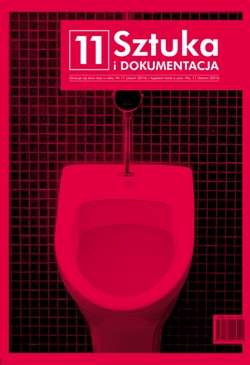Teletechnologie, linie i cyfrowe ślady. Od sytuacjonizmu i land artu do sztuki mediów lokacyjnych
Teletechnologies, maps and digital traces. From situationism and land art to locative media art
Author(s): Anna NacherSubject(s): Fine Arts / Performing Arts
Published by: Akademia Sztuk Pięknych w Gdańsku
Keywords: land art; psychogeography; drifting; locative media art; neogeography; walking-based art; psychogeografia; dryf; sztuka mediów lokacyjnych; neogeografia; sztuka chodzenia
Summary/Abstract: The article is aimed at analysing the common theoretical thread running through several walkingbased projects, classifi ed as situationist, land art and / or locative media art. My main point of departure is the following question: how do the spatial characteristics of such projects relate to the concept of geometrical line? Drawing upon the proposition of Tim Ingold I look at how particular art projects problematize the regularity of line: either through the idea of situationist drift or through ambiguous forms of materializations embodied in the walking-based artworks by Hamish Fulton and Richard Long. What is quite evident in such instances is the fact that respective practices constituting the work of art in fact address the issue of spatial regimes based on geometrical, straight line which - according to the conclusions off ered by Ingold in his book Lines: A Brief History - can be seen as a foundational feature for both the Lefebvrian notion of abstract space and the very old media technology of writing (which means production of meaning by the use of a set of signs inscribed on a surface). Lefebvre reminds us in his Production of Space that such models of abstract space, embodied in traditional cartography and bureaucratic regimes of urban management tend to favor the stable discursive items over the elusive facts of lived space, to the extent that any discourse based on clearly marked signs gets entwined with the very fact of intelligibility. Therefore, the situationist drifts and the idea of psychogeography can be seen as the subversion of the discourse of straight line, similarly to walks performed by Hamish Fulton (who prefers not to leave any trace on the surface while walking and for whom the artwork itself is constituted with the very act of movement) and Richard Long (who performs the lines on surfaces either with persistent walking or with natural materials like stones, albeit their ambivalent materializations raise doubts as to the nature of line: the very idea of a straight line seen as unitary phenomenon gets subverted). However, the case of locative media art is entirely diff erent: the reality of digital tracking has to be considered which radically changes the meaning of the projects based on the idea of situationist drift. Getting lost is barely possible; as a matter of fact, every performance gets its digital trace produced by the acts of logging in and joining the networks. Hence some of the artists tend to shift their attention to the very technical tools that enable localization of the subjects in space (mostly GPS), aiming at diff erent strategies of dislocating such technology to the eff ect of its subversion. It means, however, that even if diff erent spatial regimes are at stake, the analysis of the concept of line embodied in the walking-based artworks is theoretically fruitful and may shed more light on the spatially oriented media art.
Journal: Sztuka i Dokumentacja
- Issue Year: 2014
- Issue No: 11
- Page Range: 71-78
- Page Count: 8
- Language: Polish

